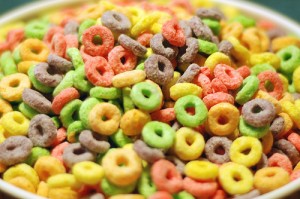
Other than toys, there is not a product more targeted at children than sugary cereals. From cartoon characters to prizes in boxes, I succumbed to the lure of Captain Crunch and the Trix Bunny as a child. At least organic cereals try to appeal to children by educating them about endangered species. Marketing strategies aside, many commercial cereals are chock full of artificial colors and flavorings linked to hyperactivity in children; however, there is a new threat to our health from cereal: petrochemical 2-methylnaphthalene.
One might assume this petrochemical is present in children’s cereals from conventional farming methods, yet the source is actually the packaging. Natural News reports how 2- methylnaphthalene ended up in Kellogg brand cereals:
It turns out this chemical was most likely released from the wax paper cereal liners that hold the cereal. This could have been due to the heating of the wax paper when it’s sealed. This causes the off-gassing of chemicals which can then be absorbed by the cereal itself.
The effect was so bad that the FDA received dozens of complaints from consumers who could taste and smell the chemical. Some said the cereal made them feel ill.
A recall followed, but the FDA did nothing to explore the safety of this chemical used in packaging. I can’t help but wonder if even the organic cereals we eat use the same wax lining bags that contain this chemical however small the amount? We may eat organic food, but if it comes in packaging, we may not be as safe from chemicals as we assume.
When you really look at our world and everything we touch / eat / interact with on a daily basis it’s scary. The chemicals are everywhere and you’re right, the organic cereals have the same chemical reactions in their wax sealing. Anything packaged has risks, but so does life, you can’t live in a bubble. I say protect your kids as best as you can but don’t over analyze every. single. thing. or you’ll drive yourself batty.
Mariah (mom of 4 healthy kids who doesn’t obsess and the kids are still alive)
I’ve no idea if this is the same chemical involved or not… but a few years ago, I got a box of an organic maple crunch cereal which I had been REALLY enjoying for my breakfasts. Super tasty and healthy ingredients.
This one box stank when I opened it. Hard to describe the smell, and it was a few years ago now so I don’t even really recall it well enough to compare it to anything. And the bag was partly unsealed.
I called the company, and they immediately apologized and said they’d send me a coupon for a free box. I was satisfied with that. Imagine my surprise when a week or so later, a courier arrives at the door with a CASE OF CEREAL. Yup, an entire case — not just one box, and certainly not just a coupon. It lasted us for months and we enjoyed every speck of it.
Now I’m curious if, indeed, they use that same chemical in their packaging…
Mariah: It IS scary to realize that we are surrounded by petro-chemicals. It’s hard to avoid…But we can try. Wood and natural fiber toys in our house for sure! I’m not even comfortable with plastics that say BPA free, especially for those things that will be touching our food. We have ditched our plastic tupperware for glass.
And scarier is that 90% of the plastic stuff comes from China, where standards are a bit loose to put it lightly.
Not a surprise then that the packaging is contaminating this already sorry excuse for food: cereal. Why is cereal that standard go-to breakfast? Processed food is not what I plan on setting in front of my child. I ditched processed breakfast cereal a while ago, when I went to a Whole Foods and found only ONE cereal that had no added sugar. I realized that just b/c I buy it from Whole Foods does not make it healthy.